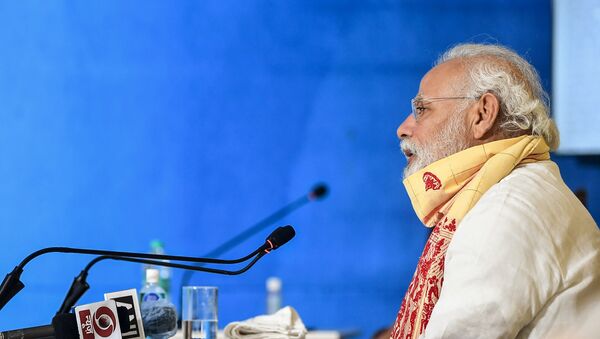India is currently battling several natural and man-made disasters including cyclones, earthquakes and gruesome cases of animal brutality.
Therefore, in a bid to make people more thoughtful about nature, leaders including Prime Minister Narendra Modi and President Ram Nath Kovind have urged Indians to pledge to preserve Earth’s rich biodiversity.
On #WorldEnvironmentDay, we reiterate our pledge to preserve our planet’s rich biodiversity. Let us collectively do whatever possible to ensure the flora and fauna with whom we share the Earth thrive. May we leave an even better planet for the coming generations. pic.twitter.com/nPBMthR1kr
— Narendra Modi (@narendramodi) June 5, 2020
We mark the occasion this year amid the COVID-19 pandemic. The world has united effectively in meeting the challenge, and I am confident we all have learnt the right lessons and resolved to emerge from the present crisis stronger and wiser.
— President of India (@rashtrapatibhvn) June 5, 2020
Are Promises Made to be Broken?
In his first term as Prime Minister, Modi was criticized by environmentalists after India ranked 177th - fourth from bottom - in the Environment Performance Index.
The country's poor performance is due to the rampant violation of environmental laws in the country in the past few years. The index--compiled by Yale and Columbia Universities in collaboration with the World Economic Forum—analysed countries on 24 performance indicators across 10 categories covering environmental health and ecosystem vitality.
Despite the several promises of "Green India" and cleaner rivers by the government, the country is under pressure of deforestation and chemical and industrial pollution as well as overpopulation.
“Almost 70 percent of the Indian population lives in villages and as a result their dependency on forests is immediate and obligatory. This puts them in direct conjugation with the wild animals who are equally dependent on the same piece of land for their survival,” Vandana Pandey, former human-wildlife conflict mitigation officer at the Wildlife Trust of India (WTI) and an environmental expert told Sputnik.
Brutal instances on how humans meddle with nature recently made headlines in India after a pregnant elephant was allegedly fed with cracker-stuffed pineapple by local residents in Kerala began making the rounds on social media. The elephant died a painful death after the crackers exploded in her mouth.
The pregnant elephant was fed a pineapple stuffed with firecrackers that eventually disabled the animal from eating or drinking. The animal eventually died standing in a river on May 27 near the Silent Valley National Park in Kerala.
— Syeda H Zainab (@i_pekachu) June 4, 2020
#KeralaElephantMurder pic.twitter.com/y1AfsAESn2
Another video of humans interfering with the natural hunting pattern of a python, who had strangled a deer cub as its prey also surfaced on social media. Several forest officials took to social networking platforms to educate people on not “saving” one wild animal from another because that severely affects their food chain.
A huge snake squeezes a deer who wants to kill it & then swallow it, but someone took a tree branch & hit the snake and managed to save the deer in an incident that gained high interaction in Thai media.
— عبد العزيز طارق 🇶🇦 (@AbdulAziztareq3) June 2, 2020
The accident occurred at Khao Khaiou Open Park, Chonburi Province,Thailand. pic.twitter.com/ug2AFgVyax
“The detrimental impact of human civilization on wildlife in India dates back to the pre-independence era. Whether it was trophy hunting or present day scenario of human-wildlife conflict, the lives of animals was always at stake. Although the Wildlife Protection Act (1972) was put in place to curb the incessant killing of wild animals, the implementation of the Act is still a debacle,” Pandey noted.
A recent India State of Forest Report released by the government claimed that nearly 25 percent (one fourth) of India’s total land area is now under forest and tree cover.
“Since 2014 (when Prime Minister Narendra Modi led government assumed power at the national level), there has been an increase of more than 13,000 sq. km. of tree and forest cover in India (13,209 sq. k.m),” said India’s Minister of Environment and Forst Prakash Javadekar.
Yet, the report also shows that forests in tribal areas in north east India are decreasing.
Due to unabated burning of farm residue across the north India.the smog levels in Indian capital Delhi have become dangerously high.
During the lockdown, pollution levels in Delhi have been stable – proving that nature can heal itself, if humans give it a chance.
After being locked down and confined inside their houses for nearly three months now, Indians have begun to feel more responsible towards the planet – as is reflected by their tweets on World Environment Day.
Today is the annual ritual of #WorldEnvironmentDay where even those who are busy working hard to destroy the ecological balance reaffirm their commitment to protect the environment.
— Jairam Ramesh (@Jairam_Ramesh) June 5, 2020
Actions round the year speak louder than any invocation of ancient wisdom today.
Let's love our nature
— मृत्युंजय सौरदीप (@Souradeep388) June 5, 2020
Nature will love us.
❤❤❤😾😾#WorldEnvironmentDay pic.twitter.com/hHzIB7KkC7
Sandart of World Environment Day by @sudarsansand #WorldEnvironmentDay #sandart pic.twitter.com/SwBMTCsS4J
— Deepak Mallik#Stay Home#Stay Safe (@Deepak_4424) June 5, 2020


